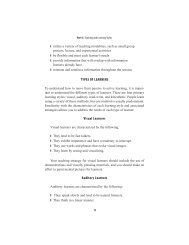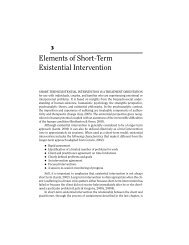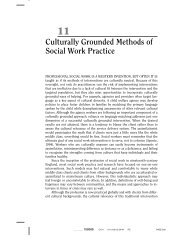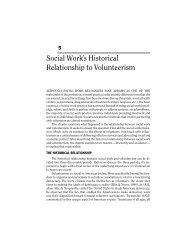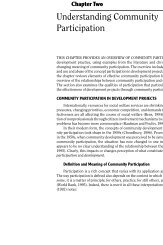An Experiential Approach to Group Work - Lyceum Books
An Experiential Approach to Group Work - Lyceum Books
An Experiential Approach to Group Work - Lyceum Books
Create successful ePaper yourself
Turn your PDF publications into a flip-book with our unique Google optimized e-Paper software.
FM 11/17/08 8:33 AM Page x<br />
book <strong>to</strong> discuss work with all populations. As such, we have relied on our expertise<br />
and practice experiences <strong>to</strong> present you with chapters that illustrate group<br />
work with six different populations.<br />
Eating disorders are an increasingly common type of psychological disorder that<br />
social workers need <strong>to</strong> address. <strong>An</strong>orexia and bulimia are not only psychological<br />
disorders, but problems with strong social causes and effects. Social norms<br />
around body image and gender have strong implications for group workers who<br />
are called <strong>to</strong> work with those suffering from these ailments. Chapter 12 presents<br />
guidance on the types of groups that have been shown <strong>to</strong> be effective with persons<br />
suffering from eating disorders.<br />
One of the contexts in which group work has maintained a central place is in<br />
the provision of services <strong>to</strong> persistently mentally ill adults. Community mental<br />
health centers have long used psychoeducational and support groups in working<br />
with persons suffering from severe and persistent mental illnesses. Chapter<br />
13 demonstrates the scope of group work with this vulnerable population.<br />
In chapter 14, we explore a highly specialized group: conflict resolution groups<br />
within elementary schools. With the increase in highly publicized incidences of<br />
school violence over the last several years, creating safe and nonviolent school<br />
contexts is extremely important. However, as schools contend with increased<br />
demands and expectations <strong>to</strong> provide more with less, fewer non-academic personnel<br />
may be available <strong>to</strong> provide direct services. As such, we anticipate the<br />
role of such groups <strong>to</strong> take on increased importance over the next several years.<br />
Other important and highly specialized groups are those designed <strong>to</strong> provide<br />
services <strong>to</strong> pregnant teens. Pregnant teens, who often feel isolated and alone,<br />
can receive a great deal of mutual support and acceptance and practice skills in<br />
groups. Chapter 15 addresses the complex developmental and social needs of<br />
these young women.<br />
Latinos are now the largest minority population in the United States. A diverse<br />
population, Latinos are expected <strong>to</strong> constitute nearly a quarter of the population<br />
of the United States within the next several decades. In chapter 16, we explore<br />
how groups can be valuable in work with Latino clients. Social workers who<br />
have linguistic and cultural competence <strong>to</strong> work with Latinos will find themselves<br />
in high demand.<br />
Chapter 17 explores group work practice with HIV-positive clients and clients<br />
with AIDS. While HIV/AIDS has received less attention in the popular media over<br />
the last decade, within some communities, its prevalence is rising.<br />
x





